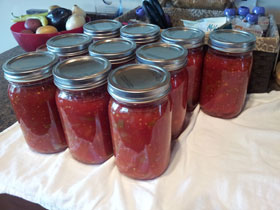Since canned tomatoes are one of the products that has the highest amounts of BPA (due to the acidity of the tomatoes, more lining is necessary on the cans), they were one of the first things I got rid of out of my cupboard. As someone who didn’t have a ton of experience in the kitchen, but tended to use a lot of canned tomatoes in what I did cook, this was without a doubt the hardest part about getting rid of BPA for me.
Just as an example, here are a few of the “staple” meals in our house before I began this journey:
– Chili (stewed tomatoes)
– Goulash (diced tomatoes & tomato paste)
– Spanish rice-a-roni (diced tomatoes)
So, what are the options if you don’t use canned tomatoes?
Fresh tomatoes – this would be ideal, right? Garden fresh (or grocery store fresh) tomatoes for all meals requiring tomatoes. Except… who has time to blanch, skin, and slice tomatoes before making a meal that would otherwise only take 15-20 minutes to make? This was not an ideal solution for me – I tend to decide what I’m cooking about 5 minutes before start. Besides, fresh tomatoes aren’t always the best year-round.
BPA-free cans – Muir Glen, a General Mills family product, announced in 2010 that they’d be switching to BPA-free cans for their tomatoes “at the next harvest.” In 2011 I came across an article that pointed to these being in stores. I apparently don’t shop at stores that carry this brand, as the only time I’ve ever seen them was when I was working at the General Mills headquarters and I stopped by their on-site store. One thing that makes me nervous about these is that they still have to be lined with something due to the acidity of the tomatoes. Muir Glen/General Mills, as far as I know, haven’t provided info on what they’re lining the cans with now.
Alternate commercial packaging – jarred tomatoes and tomatoes in cartons (or Tetra Pak) are the two options I found here. Both are surprisingly hard to come by. In fact, I have never seen either option at Target or Walmart. I did find tomatoes in cartons on Amazon from Pomi. The downside to these is that they’re expensive, and they don’t come in the traditional sizing that canned tomatoes are in, so you have to plan a bit when following a recipe. I also haven’t been able to find them locally. The company seems pretty committed to providing a quality, BPA-free tomato product, and so far they’ve got an A+ in my book.
Home canned (jarred) tomatoes – my mom and I canned about 40lbs of tomatoes this past fall. My mom has canned many times, but this was my first time participating as an adult. It wasn’t the most awesome experience ever, but it also wasn’t horrible, and I’ll be doing it again this fall – hopefully with home-grown tomatoes. We made stewed tomatoes and tomato soup. Besides the time and effort needed for this, a downside again is that the jars aren’t the typical sizes called for in recipes. I am aware that the lids of these jars contain BPA, but since I personally canned them, I know that the tomatoes didn’t touch the lids. There are BPA-free lids that can be used, but from the research I’ve done, I want to be a bit more experienced with canning before I use them.
Frozen tomatoes – this is an option I need to explore a bit more. Though my freezers are currently close to capacity (some organization would likely help!), the convenience of having tomatoes in the freezer might even be worth adding another freezer.
So – there are definitely options if you decide to get rid of the cans in your home. As you can see from my descriptions, I use several options together – sometimes certain options work better for a recipe than others. It’s all pretty much trial and error – hopefully this post will eliminate some of the error for others!

